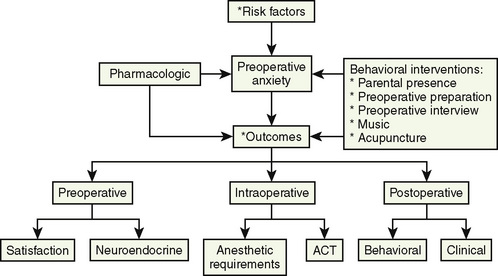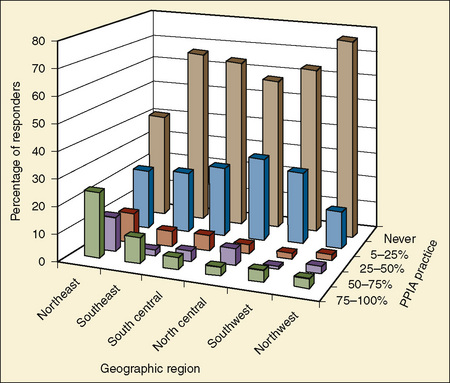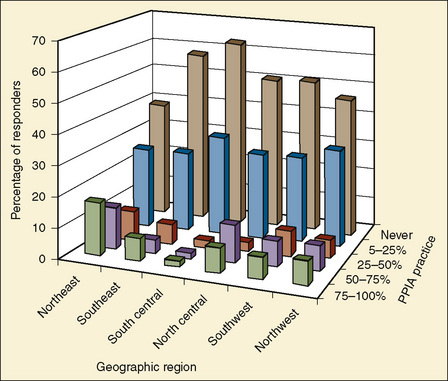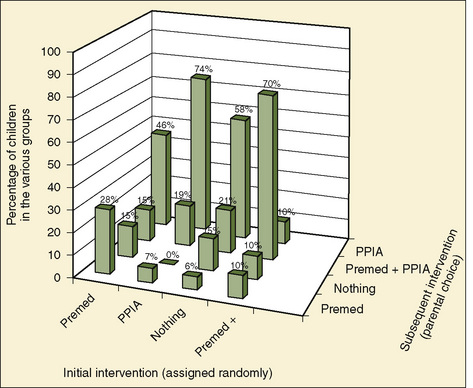CHAPTER 8 Psychological Aspects of Pediatric Anesthesia
Surgery and anesthesia are causes for considerable emotional stress in both parents and children. Because the consequences of this stress occur in the immediate postoperative period and may remain long after the hospital experience has passed, one of the main tasks of the pediatric anesthesiologist is to ensure the psychological, as well as the physiologic, well-being of patients (Chapman et al., 1956; Kain and Mayes, 1996; Kotiniemi et al., 1997a, 1997b; Holm-Knudsen et al., 1998; Aono et al., 1999; Kain et al., 1999a, 1999b, 2006a). To minimize the emotional stress of anesthesia and surgery, the anesthesiologist must understand the psychological developmental milestones of childhood and anticipate situations that a child may find threatening. The latter can often be accomplished with preoperative education, a careful and thoughtful preoperative visit, and the administration of preoperative sedation when other measures are inadequate. During the preoperative visit with the patient, the anesthesiologist can optimally evaluate the levels of anxiety of both the parent(s) and the child, while assessing the child’s medical condition. Of interest is that anesthesiologists are best at predicting which child in the preoperative holding area will be most anxious during induction of anesthesia (MacLaren et al., 2009). In this chapter, the psychological facets of hospitalization and surgery for children and the psychological and medical preparation of pediatric patients for anesthesia and surgery are discussed. A summary of premedications used for children undergoing anesthesia is included.
Psychological preparation for anesthesia and surgery
More than 4 million children undergo surgery in the United States each year, and it is estimated that 50% to 75% of these children experience significant fear and anxiety before their operations (Corman et al., 1958; Vernon et al., 1965; Melamed and Siegel, 1975; Beeby and Hughes, 1980; Kain et al., 1996c). Based on behavioral and physiologic measures of anxiety, induction of anesthesia in children has been identified as the most stressful point during the entire preoperative period (Kain and Mayes, 1996). Appropriate understanding and management of fear and anxiety before surgery are important, because if not managed well, they can lead to both psychological and physiologic adverse outcomes, including postoperative maladaptive behavioral changes and increased postoperative pain and analgesic requirements. As an indicator of the importance of preoperative anxiety, a panel of 72 anesthesiologists ranked various clinical outcomes with low anesthesia morbidity according to importance and frequency (Macario et al., 1999). The three clinical outcomes with the highest combined scores were incisional pain, nausea and vomiting, and preoperative anxiety. Thus, it is important to understand the psychological issues involved when a child undergoes surgery.
Incidence and Definition
Although the exact prevalence of preoperative anxiety in children is difficult to assess because of issues related to measurement and developmental variations, it is estimated that up to 75% of children are reported to exhibit significant psychological or physiologic manifestations of anxiety during the preoperative period (Corman et al., 1958; Vernon et al., 1965; Melamed and Siegel, 1975; Beeby and Hughes, 1980; Kain et al., 1996c). That is, every year up to 3 million children in the United States exhibit significant fear and anxiety before undergoing surgery.
Preoperative anxiety is operationally defined as a subjective feeling of tension, apprehension, nervousness, worry, and vigilance that is associated with increased autonomic nervous system activity (Burton, 1984; Kain and Mayes, 1996). Children are threatened by anticipated parental separation, pain or discomfort, loss of control, uncertainty about “going to sleep,” and masked strangers working in a technical, sterile, non–child-focused environment. Younger children tend to be concerned about separation from parents, and older children are more anxious about the anesthetic and surgical processes. The stress and anxiety experienced by children during induction of anesthesia represent an interaction between child-related factors and environmental conditions in the operating room. Child-related factors include age and developmental maturity, previous experience with medical procedures and illness, individual capacity for affect regulation and trait anxiety, and parental trait anxiety (Lumley et al., 1990, 1993; Kain et al., 1996c; Davidson et al., 2006).
Environmental factors related to the operating room include factors such as interactions with the medical staff, intensity of lights, level of noise produced by the staff and instrument preparation, and the number of medical personnel who interact with the child. Children may appear frightened or agitated, breathe deeply, tremble, stop talking or playing, or start to cry. Other children may become nauseated, wet themselves, have increased motor tone, or attempt to escape from the operating room personnel (Burton, 1984; Kain and Mayes, 1996). These behaviors, which are likely to prolong the induction of anesthesia, give children a sense of control over the situation and therefore diminish the sense of helplessness.
Identification of Children at Risk
Young children, between the ages of 1 and 5 years old, are reported to be at the highest risk for developing significant anxiety before anesthesia and surgery (Brophy and Erickson, 1990; Lumley et al., 1993; Vetter, 1993; Kain et al., 1996a, 1996c). At this age, children are particularly vulnerable because they are young enough to be dependent on their parents, yet old enough to recognize parental absence. Additional factors that enhance the vulnerability of this age group include the degree of inexperience in social contact, ability to communicate and benefit from psychological preparation, and ability to relieve anxiety through play (Hyson, 1983). Although the younger child may not have the cognitive ability to anticipate potential dangers or painful situations during induction of anesthesia, the older child (older than age 6 years) may anticipate pain and fear “going to sleep” (Sparrow et al., 1984). Older children may also rely on a number of coping strategies, including verbal questioning and cognitive mastery (e.g., learning about heart monitors or about what surgeons do) to mediate their anxiety.
Children who have high trait anxiety and who have experienced poor-quality medical encounters in the past are at a particularly high risk to develop high anxiety during the preoperative period (Kain et al., 1996a, 1996c; Davidson et al., 2006). Interestingly, a child who must undergo repeated surgical procedures may respond with either higher-than-expected preoperative anxiety levels or lower-than-expected preoperative anxiety levels. Based on a conditioned learning model, the preoperative situation presents unconditioned fear stimuli that occur repeatedly over short intervals. Thus, children’s previous surgical and medical histories may either exacerbate or attenuate their fear conditioning, and the quality of the previous medical experience (e.g., how distressing it was to the child) is more crucial than its occurrence (Box 8-1).
Several investigations indicate that children who have a shy and inhibited temperament show higher levels of fear and anxiety on the day of surgery compared with other children (Melamed and Ridley-Johnson, 1988; Kain et al., 2001). Conversely, children who have a more socially adaptive temperament are less anxious in the perioperative settings (Kain et al., 2001). Temperament in a child refers to individual patterns of behavior and has been compared with personality traits in adults (Buss et al., 1973; Buss and Plomin, 1975). Kagan et al. (1987) reported that temperament characteristics can be used to predict how a child responds emotionally in a stressful situation; for example, children who are “shy” or “inhibited” tend to become more anxious in novel settings, as suggested by the adrenocortical response and elevated heart rate.
A child’s anxiety before surgery is strongly affected by the state and trait anxiety of the parent (Kain et al., 1996c, 2001). Parental anxiety mediates the child’s response to stressful situations through two pathways (Kain and Mayes, 1996). First, whereas some parents may act as stress reducers for their children, parents who are anxious themselves are typically less available to respond to their children’s needs. Indeed, in these cases the child’s distress may further compound parental anxiety, thus diminishing the parent’s ability to respond effectively. The second pathway of the effect of parental anxiety on a child’s response reflects the genetics of parental disposition and anxiety. Previous research has illustrated that mothers who were more anxious in the surgical setting had children who were also more anxious and that these mothers were less able to respond to their children’s anxiety (Kagan et al., 1987).
Divorced parents, parents with lower educational levels, and parents of children who were not enrolled in a daycare setting rate themselves as significantly more anxious preoperatively (Kain et al., 1996a, 1996c). Finally, parents of children who are younger than 1 year old, parents who themselves underwent multiple hospitalizations, and parents of children who underwent multiple admissions all report being more anxious (Litman et al., 1996; Shirley et al., 1998). Preoperative anxiety in young children undergoing surgery can be managed with behavioral or pharmacologic (preoperative sedative medication) interventions, or both (Fig. 8-1).
Psychological Preparation Programs
The concept of psychological preparation of children and parents who undergo surgery was introduced almost 50 years ago (Mellish, 1969; Robinson and Kobayashi, 1991). Earlier programs provided the child with information regarding the surgical and anesthetic procedures and sought to develop a rapport between the medical staff and the child (Melamed and Siegel, 1975; Melamed et al., 1976, 1978). In the 1970s, modeling preparation programs were introduced to multiple hospitals in the United States. These modeling programs included the use of illustrated books, video programs, and puppet shows (Melamed and Siegel, 1975; Melamed et al., 1976, 1978). The theory behind these programs was that children would be prepared for the surgical experience by observing other children who underwent similar procedures. During the 1990s, the idea of family-centered care was introduced to medicine in general and to the area of preoperative preparation in particular (Melamed, 1993). Coupled with the development of the child-life discipline and the teaching of coping skills, this concept dominates the preparation programs in current use. Child-life specialists are individuals who facilitate the child’s coping and the perioperative adjustment of children and parents by providing play experiences using modeling techniques (AAP statement, 1993). Child-life specialists incorporate descriptions of the perioperative sensations children experience and provide opportunities to examine, rehearse, and play with perioperative equipment to be used in their care. Child-life specialists also aim to establish supportive relationships with children and parents and to teach relaxation skills, as well as present information to the child and parent about the anesthetic and surgical procedures (AAP statement, 1993).
The regularity with which preparation programs aimed at children undergoing surgery are being used has changed over the past decades. Although these programs were scarce in the 1970s and 1980s, they became quite popular in the 1990s. In fact, in 1996 about 80% of all major acute care children’s hospitals in the United States offered such programs to children and their parents (O’Byrne et al., 1997). Unfortunately, the number of comprehensive preparation programs has been reported as decreasing over the past few years; this new trend is likely the result of new economical constraints in the perioperative environment.
O’Byrne et al. (1997) state that he type of preparation program used varies significantly among different children’s hospitals in the United States. About 89% of children’s hospitals are reported to provide narrative preparation, 87% provide operating-room tours, 86% provide play therapy, and 84% provide printed material. More comprehensive preparation, such as child-life preparation is provided at about 50% of children’s hospitals, and relaxation is taught at about 40% of the hospitals. Interestingly, a panel of experts indicated their consensus regarding the effectiveness of psychological preparation programs before surgery. On a scale of 1 (least effective) to 9 (most effective), child-life preparation was ranked the most effective, followed by play therapy, an operating-room tour, and printed material (O’Byrne et al., 1997).
Although the effectiveness of preparation programs in reduction of anxiety in the holding area is well established, their effectiveness for reducing anxiety during the induction process is questionable (Kain et al., 1996a, 1998a). Methodologic flaws, such as the absence of an appropriate outcome instrument and small sample size, hinder many of the studies that report reduced anxiety in children. In fact, a study that included a validated outcome measure has clearly documented that although a comprehensive psychological preparation program (i.e., child life) is effective in reduction of anxiety in the holding area, it is not effective during the induction of anesthesia or in the recovery room (Kain et al., 1998a). It is likely that the extreme anxiety experienced during induction of anesthesia inhibits children’s abilities to process and implement of the content of the preoperative-preparation program.
Considerations in Choosing a Preparation Program
Timing of the preparation in relation to the day of surgery is a significant factor. That is, children aged 6 years and older benefit most if they participate in the program more than 5 to 7 days before surgery and benefit the least if the program is given 1 day before surgery (Melamed et al., 1976; Robinson and Kobayashi, 1991; Kain et al., 1996a). This extended interval between the preparation and the surgery is needed for older children to have adequate time to process new information provided to them during the preparation process (Melamed et al., 1983; Kain et al., 1996a, 1998a). Typically, older children prepared 1 week ahead of surgery show an immediate increase in the anxiety during the preparation period, with a gradual decrease until the time of surgery (Melamed et al., 1983). Interestingly, there may be a negative effect of a preparation program on younger children. This may be a result of the inability of children younger than age 3 years to separate fantasy from reality (Melamed et al., 1976; Robinson and Kobayashi, 1991). From ages 3 to 6 years, children experience increased ability to separate fantasy from reality, and by the age of 6 years, this distinction of fantasy vs. reality is typically completed (Piaget, 1955).
It is particularly challenging to design a preparation program for children who have been previously hospitalized. Information about what occurs on the day of surgery does not provide new information for these children. Studies have documented that simple modeling and play programs are not beneficial for these children and may actually sensitize these children (Melamed et al., 1983; Faust and Melamed, 1984). Alternative psychological programs, such as teaching extensive, individualized coping skills combined with actual practice, are more helpful for these children (Melamed et al., 1983; Kain et al., 1996a). These alternative programs should be based on the particular experiences the child had during previous surgeries.
Parental Issues
Clearly, preoperative preparation should be directed to parents as well as to children. Multiple studies have reported that parents typically become very anxious when their child undergoes surgery, and parental anxiety was identified as a significant risk factor for increased preoperative anxiety in children (Pinto and Hollandsworth, 1989; Kain et al., 1996a, 1996c; Litman et al., 1996; Shirley et al., 1998; Cassady et al., 1999). Parents experience preoperative anxiety for reasons such as fear of separation and bodily harm to their children, guilt, and financial stress (Cassady et al., 1999). Indeed many parents are more anxious about their children’s health than their own (Kain et al., 1997d). Mothers are more prone to preoperative anxiety than are fathers, particularly when a child is younger than 1 year old or when they are coping with a child’s first surgical experience (Litman et al., 1996; Shirley et al., 1998). Previous research has also documented that women are significantly more concerned with risks and side effects in general, although men specifically articulate a fear of death twice as often as women.
Parents who undergo a preoperative preparation program or who have viewed a preoperative videotape featuring factual information about anesthesia show reduced preoperative anxiety on the day of surgery, but this reduction in anxiety is transient and does not extend to the anesthetic induction, the recovery room, or 2 weeks postoperatively (Table 8-1) (Pinto and Hollandsworth, 1989; Kain et al., 1996a; 1998a; Cassady et al., 1999). Nonetheless, the use of videotapes has received increased attention as a supplementary educational modality for parents, because the tapes are informative, perhaps anxiolytic, and cost effective in certain settings (Pinto and Hollandsworth, 1989; Karl et al., 1990; Cassady et al., 1999; Cassady and Kain, 2000).
Future of Preparation Programs
Most surgeries in the United States are currently conducted on an outpatient basis, and as a result, many children receive preparation for surgery on the morning of the procedure. A major issue with this approach is that because of production pressure, health care providers rarely spend more than a few minutes with the child before surgery (Kain et al., 2009a). As such, a different approach is needed.
Parental Presence
Parental presence during the induction of anesthesia has been suggested as an alternative to sedative premedication. Although there is general agreement about the desirability of parents visiting during their child’s hospitalization, their presence during invasive medical procedures, such as induction of anesthesia, remains very controversial (Lerman, 2000; Kain, 2001). Potential benefits from parental presence include reducing the need for preoperative sedatives and reducing the child’s anxiety and distress on separation to the operating room. Increased child compliance and reduced child anxiety during induction of anesthesia have been suggested to be benefits as well. Common objections to this practice include delays in operating-room schedules, crowded operating rooms, and a possible adverse reaction of the parent during the induction process.
A large-scale, nationwide survey indicated that there is a large variability in hospital policy in the United States toward parental presence in operating rooms. Thirty-two percent of the hospitals allow parental presence; 11% encourage parental presence; 23% have no formal hospital policy; and 26% do not allow it (Kain et al., 2004c).
The same survey reported that only 10% of anesthesiologists have parents present during induction of anesthesia in more than 75% of cases, and that 27% of anesthesiologists have parents present during induction in less than 25% of cases. About 50% of all anesthesiologists never have parents present during induction (Kain et al., 2004c). The reported prevalence of parental presence varies widely among the different geographic locations in the United States.
The survey showed that parental presence during induction of anesthesia was practiced most often in the northeast region and least often in the south-central region of the United States (Fig. 8-2). Interestingly, the findings in this survey are very much different from the findings in a nationwide survey conducted in 1995 (Kain et al., 1997c, 2004c) (Fig. 8-3). Overall, there was an increase in the rate of parental presence from 1995 to 2002, and the number of anesthesiologists who never allow parental presence dropped in every geographic region (Kain et al., 1997c, 2004c). These findings may represent a new trend in this practice in the United States.
Parental Perspectives
A number of surveys have indicated that most parents prefer to be present during the induction of anesthesia regardless of the child’s age (Braude et al., 1990; Ryder and Spargo, 1991). Furthermore, a majority of parents believe that they are of some help to their child and to the anesthesiologist during the induction process (Ryder and Spargo, 1991). A study indicates that over 80% of parents chose to be present in the operating room when returning for a second operation regardless of whether they were present in the operating room in the first operation (Kain et al., 2003b). This preference for parental presence during induction shown by parents who had experience with other interventions, including preoperative midazolam, is similar to the preference for parental presence shown by parents of children undergoing surgery for the first time (Kain et al., 2003b) (Fig. 8-4). It is no surprise, therefore, that parental presence during the induction of anesthesia is associated with increased parental satisfaction regarding not only the separation process from their child but also with the overall functioning of the hospital (Kain et al., 2000).
Many parents report increased anxiety when they are present during induction of anesthesia (Vessey et al., 1994). An investigation found, however, that anxiety after induction of anesthesia among parents who were present during induction did not differ significantly from anxiety among parents who were not present during the induction process (Kain et al., 2003a). This finding is in agreement with previous randomized controlled trials that have examined this issue (Bevan et al., 1990; Kain et al., 1996b, 1998b, 2000).
Parental physiologic responses during induction of anesthesia have been examined as well (Kain et al., 2003a). It was found that parental heart rate and skin conductance levels significantly increase as the parents walk to the operating room. Interestingly, once the induction begins, parental heart rate decreases, only to peak again once the parents have to leave the operating room. This second peak in heart rate is in agreement with previous data indicating that the most upsetting factors are seeing the child go limp during induction and then having to leave the child (Vessey et al., 1994). Parental blood pressure after induction of anesthesia was not elevated, and examination of parental data from a Holter monitor revealed no rhythmic abnormalities and no electrocardiographic changes indicative of ischemia (Fig. 8-5) (Kain et al., 2003a).

Full access? Get Clinical Tree













